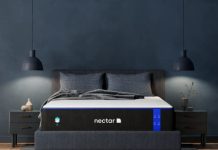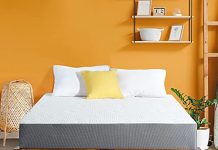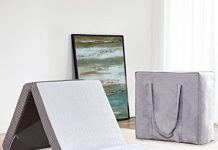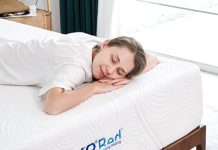Have you ever wondered what exactly floor mattresses are made of? Well, prepare to be enlightened! In this article, we will explore the materials that make up these unique sleeping surfaces. From memory foam to natural cotton, we will unravel the secrets of floor mattress construction, revealing the comfort and support that lies beneath those cozy covers. So, get ready to dive into the world of floor mattresses and discover what lies beneath their inviting exteriors.
Review contents
Introduction
Definition of a floor mattress
A floor mattress, also known as a futon or floor bed, is a type of mattress that is designed to be placed directly on the floor rather than on a traditional bed frame. It offers a versatile and space-saving sleeping solution, making it popular among people who prefer a minimalist lifestyle or those who live in smaller spaces. Floor mattresses come in various types and are made from different materials, each offering its own unique features and benefits.
1. Types of Floor Mattresses
1.1 Traditional Floor Mattresses
Traditional floor mattresses, also known as shikibutons, have been used in Japan for centuries. They are typically made from natural materials such as cotton, wool, or a combination of both. These mattresses are thin, lightweight, and easy to roll or fold, making them highly portable and convenient for storage. Traditional floor mattresses provide a firm sleeping surface and are known for their durability.
1.2 Japanese Futon Mattresses
Japanese futon mattresses are similar to traditional floor mattresses but often have a slightly thicker construction. They are typically made from layers of cotton batting encased in a quilted cover. Futon mattresses are known for their ability to conform to the body’s shape, providing excellent support and comfort. Due to their thickness, they may require more storage space compared to traditional floor mattresses.
1.3 Foam Floor Mattresses
Foam floor mattresses are a modern and versatile option. They are constructed with layers of high-density foam or memory foam, providing excellent support and cushioning. Foam floor mattresses are known for their ability to contour to the body’s shape, relieving pressure points and promoting proper spinal alignment. They are often thicker and heavier than traditional floor mattresses, but some models are designed to be easily foldable for storage purposes.
2. Common Materials Used in Floor Mattresses
2.1 Cotton
Cotton is a popular material used in floor mattresses due to its breathability and comfort. It is a natural fabric that allows air to circulate, keeping the mattress cool and preventing the build-up of moisture. Cotton also feels soft to the touch and is hypoallergenic, making it an excellent choice for individuals with sensitive skin or allergies.
2.2 Polyester
Polyester is a synthetic material commonly used in floor mattresses. It is durable, lightweight, and resistant to wrinkles and shrinking. Polyester mattresses are known for their affordability and easy maintenance. However, they may not be as breathable as natural materials and may retain heat, making them less suitable for hot sleepers.
2.3 Wool
Wool is a natural material that is highly breathable and regulates body temperature effectively. It provides excellent insulation during colder months and wicks away moisture, keeping the sleeper cool and dry. Wool floor mattresses are known for their durability and resilience, as well as their ability to naturally repel dust mites and other allergens.
2.4 Memory Foam
Memory foam is a popular material used in many mattresses, including floor mattresses. It conforms to the body’s shape, evenly distributing body weight and relieving pressure points. Memory foam mattresses provide excellent support and motion isolation, making them a suitable choice for couples or individuals who share a sleeping space.
2.5 Latex
Latex is a natural material derived from the sap of rubber trees. It is known for its responsiveness and durability. Latex floor mattresses offer excellent support and contouring properties similar to memory foam, but with a more natural and eco-friendly composition. Latex is also resistant to mold, mildew, and dust mites, making it a suitable choice for individuals with allergies.
2.6 Microfiber
Microfiber is a synthetic material that is lightweight and soft to the touch. It is often used as a cover material for floor mattresses due to its durability and ease of cleaning. Microfiber mattresses are hypoallergenic and resistant to dust mites and allergens, making them suitable for individuals with allergies or asthma.
2.7 Natural Fibers
Apart from cotton and wool, other natural fibers such as bamboo and hemp are also used in floor mattresses. Bamboo is known for its breathability and antimicrobial properties, while hemp is durable and eco-friendly. Floor mattresses made from natural fibers offer a comfortable and sustainable sleeping surface.
2.8 Synthetic Fibers
Synthetic fibers such as nylon and polyester blends are commonly used in floor mattresses due to their durability and affordability. These materials are often combined with other fabrics to enhance comfort and support.
2.9 Bamboo
Bamboo is a natural material known for its breathability, moisture-wicking properties, and antimicrobial attributes. It provides a cool and comfortable sleeping surface and is a sustainable choice for eco-conscious individuals.
2.10 Coil Springs
Some floor mattresses feature coil spring systems for added support and stability. These mattresses contain individually wrapped coils that respond independently to the body’s movements, reducing motion transfer and enhancing comfort.
3. Benefits of Different Materials
3.1 Cotton
Cotton floor mattresses are highly breathable, providing a cool and comfortable sleep surface. They are hypoallergenic and easy to clean, making them suitable for individuals with allergies or sensitivities. Cotton mattresses are also lightweight and portable, allowing for easy storage and transportation.
3.2 Polyester
Polyester floor mattresses are affordable and low-maintenance. They are resistant to wrinkles and shrinking, making them an ideal choice for individuals seeking a durable and easy-to-care-for mattress. However, polyester may not offer the same level of breathability as natural materials.
3.3 Wool
Wool floor mattresses offer excellent insulation and are highly breathable, making them suitable for both cold and warm climates. They naturally repel dust mites and allergens, providing a hypoallergenic sleep environment. Wool mattresses are also known for their durability and resilience.
3.4 Memory Foam
Memory foam floor mattresses provide superior support and conform to the body’s contours, relieving pressure points and promoting proper spinal alignment. They offer excellent motion isolation, making them ideal for couples or individuals sharing a sleeping space. Memory foam mattresses may retain heat, so they may be better suited for individuals who sleep cool.
3.5 Latex
Latex floor mattresses offer responsive support and conform to the body’s shape. They are durable, hypoallergenic, and resistant to mold, mildew, and dust mites. Latex mattresses provide a natural and eco-friendly sleep surface with excellent breathability.
3.6 Microfiber
Microfiber floor mattresses are lightweight, soft, and hypoallergenic. They resist dust mites and allergens and are easy to clean. Microfiber mattresses are a great choice for individuals with allergies or asthma.
3.7 Natural Fibers
Natural fiber floor mattresses, such as those made from bamboo or hemp, offer breathability, antimicrobial properties, and sustainability. They provide a comfortable and eco-friendly sleep environment.
3.8 Synthetic Fibers
Synthetic fiber floor mattresses are durable and affordable. They often feature blends with other materials to enhance comfort and support.
3.9 Bamboo
Bamboo floor mattresses offer breathability, moisture-wicking properties, and are antimicrobial. They provide a cool sleep surface and are suitable for individuals seeking a sustainable sleep solution.
3.10 Coil Springs
Floor mattresses with coil springs offer additional support and stability. The individually wrapped coils respond independently to the body’s movements, reducing motion transfer and enhancing overall comfort.
4. Factors to Consider When Choosing a Floor Mattress
4.1 Comfort
Comfort is a crucial factor to consider when choosing a floor mattress. Look for a mattress that provides adequate support, cushioning, and conforms to your body’s contours for a comfortable night’s sleep. Different materials and construction methods can influence the overall comfort level of a floor mattress.
4.2 Durability
Durability is important to ensure the longevity of your floor mattress. Consider the materials used and the construction quality of the mattress. Natural materials such as cotton, wool, and latex are known for their durability, while synthetic materials like polyester and microfiber often offer good durability at a more affordable price point.
4.3 Thickness
The thickness of a floor mattress can impact its comfort and portability. Thicker mattresses may provide more cushioning and support but can be less portable and harder to store. Thinner mattresses, on the other hand, may be more lightweight and easier to roll or fold for storage.
4.4 Breathability
Breathability is essential for a comfortable sleep experience, especially if you tend to sleep hot. Look for materials that allow air to flow freely, such as cotton or natural fibers like bamboo. These materials help regulate temperature and prevent the build-up of moisture and heat.
4.5 Hypoallergenic Properties
If you have allergies or sensitivities, consider a hypoallergenic floor mattress. Natural materials like wool, latex, and cotton are often hypoallergenic and resistant to dust mites and allergens. Synthetic materials like microfiber are also hypoallergenic and can provide a suitable alternative.
4.6 Ease of Cleaning
Consider the ease of cleaning and maintenance when choosing a floor mattress. Look for materials that are easy to spot-clean or machine wash. Some mattresses may require professional cleaning, so factor in the additional costs and effort.
4.7 Price
Price is an important consideration for many when choosing a floor mattress. Different materials and construction methods can greatly affect the price range. Set a budget and consider the features and benefits that are most important to you.
4.8 Size and Portability
Consider the size and portability of the floor mattress, especially if you plan to transport or store it frequently. Thinner mattresses are generally more portable and easier to store, while larger sizes may offer more sleeping space but require more storage space.
4.9 Noise
Some types of materials, such as coil springs, may produce noise when pressure is applied. If you are easily disturbed by noise or plan to use the mattress in a shared living space, consider materials with minimal noise production.
4.10 Personal Preferences
Ultimately, personal preferences play a crucial role in choosing a floor mattress. Consider factors such as firmness, sleeping position, and any specific health conditions or needs you may have. Test out different mattresses if possible to determine which one suits your preferences and needs the best.
5. Care and Maintenance of Floor Mattresses
5.1 Regular Cleaning
Regular cleaning is important to maintain the hygiene and longevity of your floor mattress. Remove any bedding and use a vacuum cleaner or a soft brush attachment to remove dust and debris from the mattress surface. This should be done every couple of weeks or as needed.
5.2 Spot Cleaning
For spills or stains, spot cleaning is recommended. Blot the affected area with a mild detergent mixed with water using a clean cloth or sponge. Avoid saturating the mattress, as excessive moisture can lead to mold or mildew growth. Allow the mattress to air dry thoroughly.
5.3 Drying
If your floor mattress becomes wet, allow it to dry completely before using or storing. Moisture can cause mold and unpleasant odors, so it’s important to ensure the mattress is adequately dried.
5.4 Rotation and Fluffing
To maintain even wear and extend the lifespan of your floor mattress, rotate it regularly. This helps distribute the weight and pressure evenly across the mattress. Additionally, fluffing the mattress occasionally can help restore its shape and resilience.
5.5 Storage
When not in use, store your floor mattress in a clean and dry area. Make sure it is properly folded or rolled according to the manufacturer’s instructions. Avoid storing the mattress in damp or humid environments to prevent mold or mildew growth.
6. Conclusion
Floor mattresses offer a versatile and space-saving sleeping solution for individuals seeking a minimalist lifestyle or living in smaller spaces. They come in various types and are made from different materials, each offering its own unique features and benefits. When choosing a floor mattress, consider factors such as comfort, durability, thickness, breathability, hypoallergenic properties, ease of cleaning, price, size, noise, and personal preferences. Regular cleaning, spot cleaning, proper drying, rotation, and fluffing are important for the care and maintenance of floor mattresses. With a wide range of options available, you can find a floor mattress that suits your needs and offers a comfortable and restful sleeping experience.



























